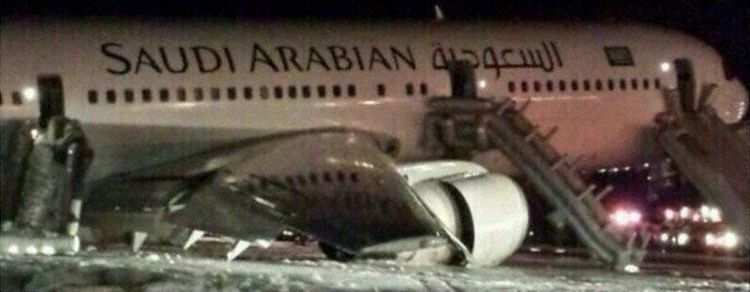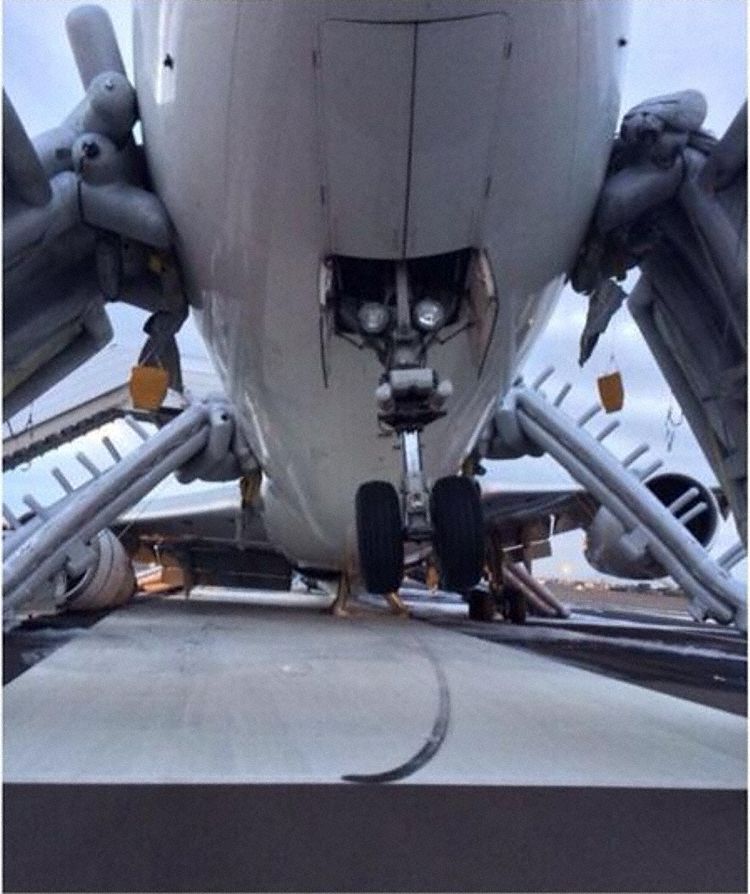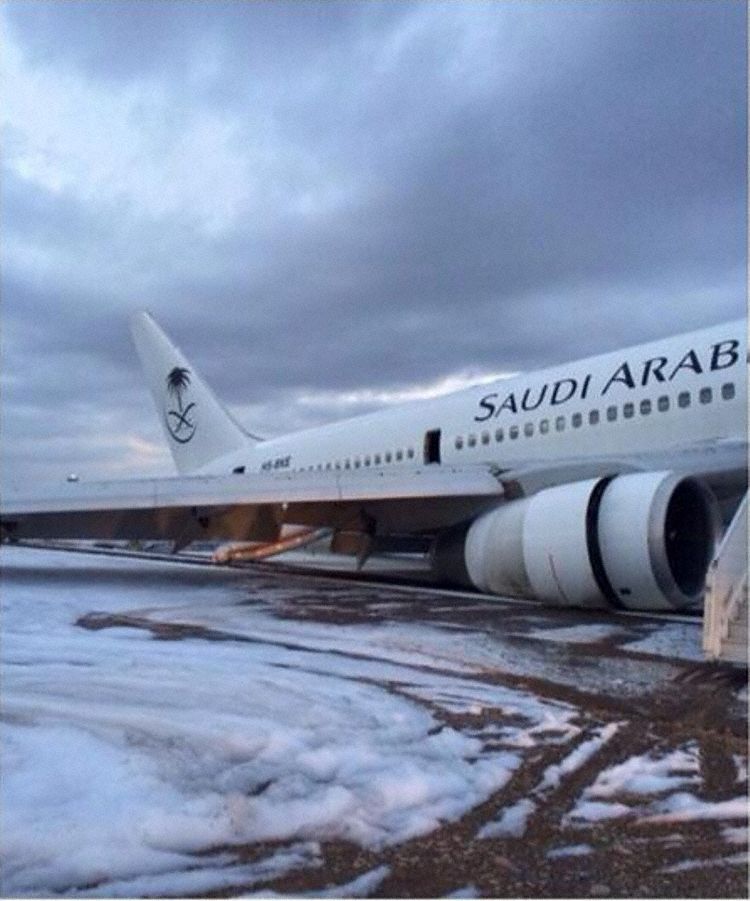A Saudi Arabian Airlines Boeing 767-300, registration HS-BKE performing flight SV-2841 from Mashad (Iran) to Madinah (Saudi Arabia) with 299 passengers and 16 crew, was on approach to Madinah when the crew received an unsafe indication for the right hand main gear and aborted the approach at about 03:30L (00:30Z). The aircraft entered a hold to work the relevant checklists, the crew was unable to resolve the problem however confirmed by a low approach to the airport. The aircraft subsequently positioned for a third approach and performed a partial gear up landing at Madinah, the aircraft came to a stop on the runway resting on left main and nose gear and right hand engine. 29 passengers received injuries in the subsequent evacuation, 11 of them were taken to hospitals, the others were treated on scene.
Saudi Arabia's Civil Aviation Authority (GACA) reported there had been a technical problem with the right hand main gear forcing the crew to land without the right hand main gear extended. As result of the evacuation and people pushing each other 29 passengers received minor injuries, 11 of which were taken to hospitals and 18 were treated at the airport.
The airport was closed for 24 hours as result of the accident.
HS-BKE is owned by Orient Thai Airlines but had been leased out to Saudi Arabian Airlines on Aug 29th 2013.
On Oct 11th 2025 The Aviation Herald received a copy of the final report by Saudi Arabia's Accident Investigation Bureau (SAAIB) concluding the probable causes of the accident were:
Cause Related Findings:
- Mongolian Airlines, the C-11 maintenance check provider, did not identify the number 1 or number 7 brake assemblies having eroded safety wire holes in the lock bolts when performing a C-11 maintenance check.
- All lock bolts installed on the brake rod retaining bolts should have been identified and evaluated. for serviceability and replaced as necessary.
- Orient Thai did not identify eroded safety wire holes in the lock bolts during the performance of maintenance activities including, brake replacement tasks, daily checks and transit checks.
- Orient Thai flight crew(s) did not detect the loosened brake rod retaining bolt on the right main landing gear (RMLG) aft inboard brake when performing pre-flight inspections.
- During the-last flight ofHS-BKE, the RMLG aft inboard brake rod retaining bolt was loose.
- The RMLG aft inboard brake rod retaining bolt became disconnected from the pin.
- The RMLG aft inboard pin fell away from the RMLG aft inboard brake and brake rod.
- After the retraction of the landing gear, the RMLG aft inboard brake rod migrated inboard wedging itself on the RMLG upstop/lock fitting structure
- The RMLG could not be lowered into the extended position during the landing into Madinah.
- The accident was precipitated by the loss of two lock bolts that were not (or were not able to be) safety wired in place. Safety wiring the lock bolts would have prevented the RMLG brake rod retaining bolt from loosening and falling away from the pin.
- Orient Thai senior management allowed employees to use inappropriate substandard procedures that were contrary to its air carrier procedures, its Operations Specifications, and industry safety risk management processes.
- Orient Thai did not adhere to its General Maintenance Manual (GMM) that was prepared to provide information on rules, regulations, standards, requirements, policies, procedures, and safety practices in order to ensure continuing airworthiness of HS-BKE.
- Orient Thai, Mongolian Airlines maintenance organization, and the Thailand Department of Civil Aviation (DCA), did not appropriately utilize policies, procedures, and safety risk management concepts resulting in the culmination of this occurrence long before the accident occurred.
Other Findings
- The maintenance release for the aircraft C-11 check, performed by Mongolian Airlines, was· issued outside the privileges granted by European Aviation Safety Agency (EASA).
- Air Traffic Control (ATC) did not contribute to the accident.
- Aids to navigation were working properly and did not contribute to the accident.
- The Aerodrome and its associated facilities did not contribute to the accident.
- The Fire Rescue ·service (FRS) response was rapid and· efficient, extinguishing a fire at the base of the right engine when responding to the accident site.
- The meteorological conditions did not contribute to the accident.
- The flight crew was properly licensed and was qualified on the Boeing 767.
- Orient Thai aircraft maintenance. technicians were properly trained
according to Orient Thai records.
- The mass and center of gravity of the aircraft were within the prescribed limits.
- FAA Airworthiness Directive (AD) 2009-20-02, effective 03 November 2009, had no provision for air operators to amend their emergency evacuation procedures jf an extreme tip back condition was encountered during an emergency evacuation of an applicable B-767.
- The Orient Thai Flight Attendant Manual contained inaccurate information stating, "All slide/raft are useable whatever the attitude of the aircraft" which is contrary to AD 2009-20-02.
- The Orient Thai Flight Attendant Manual did not contain precautionary procedures for use of the forward and mid-cabin slides during extreme fuselage tip back condition.
- L-1 slide inflated properly but was at an angle to the ground that was
too steep for use due to the RMLG not extending and the extreme fuselage tip back condition occurring.
- Cargo and equipment were improperly stored in the MEC of HSBKE.
- Cargo and equipment were improperly stored in the ]VIEC of HSBKA.
- Unsecured bottles of soap where placed in the lavatories ofHS-BKE.
- Orient Thai was carrying Dangerous Goods contrary to its contract obligations as stated in the wet lease agreement.
- Orient Thai certified aircraft maintenance records were maintained improperly, were not accurate, and contained record keeping ambiguities.
- The Orient Thai AD current status summary contained inaccurate criteria while being certified by the air carrier.
- Orient Thai maintained Operational Control of HS-BKE during the wet-lease contract and was responsible for all HS-BKE operations and activities.
- Orient Thai had adequate procedures in its GJ\IIM but elected not follow these procedures.
- Orient Thai did not receive appropriate regulatory oversight by its certificating state authority.
- Orient Thai did not receive appropriate regulatory oversight by the General Authority of Civil Aviation (GACA).
- Saudi Arabia Airlines did not adequately perform audits- and oversight of the Orient Thai.
Related NOTAM:
A0031/14 - AD CLSD DUE TO EMERG BLOCKING THE RWY IN USE. 05 JAN 01:15 2014 UNTIL 06 JAN 01:15 2014. CREATED: 05 JAN 04:47 2014
Metars:
OEMA 050200Z 21006KT 9999 BKN045 18/13 Q1014 NOSIG
OEMA 050100Z 27004KT 9999 SCT045 19/13 Q1014 NOSIG
OEMA 050000Z 23008KT 9999 SCT045 19/14 Q1015 NOSIG
OEMA 042300Z 21007KT 9999 BKN045 19/14 Q1015 NOSIG
OEMA 042200Z 25005KT 9999 FEW045 20/14 Q1015 NOSIG
HS-BKE after landing (Photo: Ahmed AlGhamdi):

HS-BKE the following morning (Photos: Ahmed AlGhamdi):


Saudi Arabia's Civil Aviation Authority (GACA) reported there had been a technical problem with the right hand main gear forcing the crew to land without the right hand main gear extended. As result of the evacuation and people pushing each other 29 passengers received minor injuries, 11 of which were taken to hospitals and 18 were treated at the airport.
The airport was closed for 24 hours as result of the accident.
HS-BKE is owned by Orient Thai Airlines but had been leased out to Saudi Arabian Airlines on Aug 29th 2013.
On Oct 11th 2025 The Aviation Herald received a copy of the final report by Saudi Arabia's Accident Investigation Bureau (SAAIB) concluding the probable causes of the accident were:
Cause Related Findings:
- Mongolian Airlines, the C-11 maintenance check provider, did not identify the number 1 or number 7 brake assemblies having eroded safety wire holes in the lock bolts when performing a C-11 maintenance check.
- All lock bolts installed on the brake rod retaining bolts should have been identified and evaluated. for serviceability and replaced as necessary.
- Orient Thai did not identify eroded safety wire holes in the lock bolts during the performance of maintenance activities including, brake replacement tasks, daily checks and transit checks.
- Orient Thai flight crew(s) did not detect the loosened brake rod retaining bolt on the right main landing gear (RMLG) aft inboard brake when performing pre-flight inspections.
- During the-last flight ofHS-BKE, the RMLG aft inboard brake rod retaining bolt was loose.
- The RMLG aft inboard brake rod retaining bolt became disconnected from the pin.
- The RMLG aft inboard pin fell away from the RMLG aft inboard brake and brake rod.
- After the retraction of the landing gear, the RMLG aft inboard brake rod migrated inboard wedging itself on the RMLG upstop/lock fitting structure
- The RMLG could not be lowered into the extended position during the landing into Madinah.
- The accident was precipitated by the loss of two lock bolts that were not (or were not able to be) safety wired in place. Safety wiring the lock bolts would have prevented the RMLG brake rod retaining bolt from loosening and falling away from the pin.
- Orient Thai senior management allowed employees to use inappropriate substandard procedures that were contrary to its air carrier procedures, its Operations Specifications, and industry safety risk management processes.
- Orient Thai did not adhere to its General Maintenance Manual (GMM) that was prepared to provide information on rules, regulations, standards, requirements, policies, procedures, and safety practices in order to ensure continuing airworthiness of HS-BKE.
- Orient Thai, Mongolian Airlines maintenance organization, and the Thailand Department of Civil Aviation (DCA), did not appropriately utilize policies, procedures, and safety risk management concepts resulting in the culmination of this occurrence long before the accident occurred.
Other Findings
- The maintenance release for the aircraft C-11 check, performed by Mongolian Airlines, was· issued outside the privileges granted by European Aviation Safety Agency (EASA).
- Air Traffic Control (ATC) did not contribute to the accident.
- Aids to navigation were working properly and did not contribute to the accident.
- The Aerodrome and its associated facilities did not contribute to the accident.
- The Fire Rescue ·service (FRS) response was rapid and· efficient, extinguishing a fire at the base of the right engine when responding to the accident site.
- The meteorological conditions did not contribute to the accident.
- The flight crew was properly licensed and was qualified on the Boeing 767.
- Orient Thai aircraft maintenance. technicians were properly trained
according to Orient Thai records.
- The mass and center of gravity of the aircraft were within the prescribed limits.
- FAA Airworthiness Directive (AD) 2009-20-02, effective 03 November 2009, had no provision for air operators to amend their emergency evacuation procedures jf an extreme tip back condition was encountered during an emergency evacuation of an applicable B-767.
- The Orient Thai Flight Attendant Manual contained inaccurate information stating, "All slide/raft are useable whatever the attitude of the aircraft" which is contrary to AD 2009-20-02.
- The Orient Thai Flight Attendant Manual did not contain precautionary procedures for use of the forward and mid-cabin slides during extreme fuselage tip back condition.
- L-1 slide inflated properly but was at an angle to the ground that was
too steep for use due to the RMLG not extending and the extreme fuselage tip back condition occurring.
- Cargo and equipment were improperly stored in the MEC of HSBKE.
- Cargo and equipment were improperly stored in the ]VIEC of HSBKA.
- Unsecured bottles of soap where placed in the lavatories ofHS-BKE.
- Orient Thai was carrying Dangerous Goods contrary to its contract obligations as stated in the wet lease agreement.
- Orient Thai certified aircraft maintenance records were maintained improperly, were not accurate, and contained record keeping ambiguities.
- The Orient Thai AD current status summary contained inaccurate criteria while being certified by the air carrier.
- Orient Thai maintained Operational Control of HS-BKE during the wet-lease contract and was responsible for all HS-BKE operations and activities.
- Orient Thai had adequate procedures in its GJ\IIM but elected not follow these procedures.
- Orient Thai did not receive appropriate regulatory oversight by its certificating state authority.
- Orient Thai did not receive appropriate regulatory oversight by the General Authority of Civil Aviation (GACA).
- Saudi Arabia Airlines did not adequately perform audits- and oversight of the Orient Thai.
Related NOTAM:
A0031/14 - AD CLSD DUE TO EMERG BLOCKING THE RWY IN USE. 05 JAN 01:15 2014 UNTIL 06 JAN 01:15 2014. CREATED: 05 JAN 04:47 2014
Metars:
OEMA 050200Z 21006KT 9999 BKN045 18/13 Q1014 NOSIG
OEMA 050100Z 27004KT 9999 SCT045 19/13 Q1014 NOSIG
OEMA 050000Z 23008KT 9999 SCT045 19/14 Q1015 NOSIG
OEMA 042300Z 21007KT 9999 BKN045 19/14 Q1015 NOSIG
OEMA 042200Z 25005KT 9999 FEW045 20/14 Q1015 NOSIG
HS-BKE after landing (Photo: Ahmed AlGhamdi):

HS-BKE the following morning (Photos: Ahmed AlGhamdi):


This article is published under license. Article Source
Published Date















